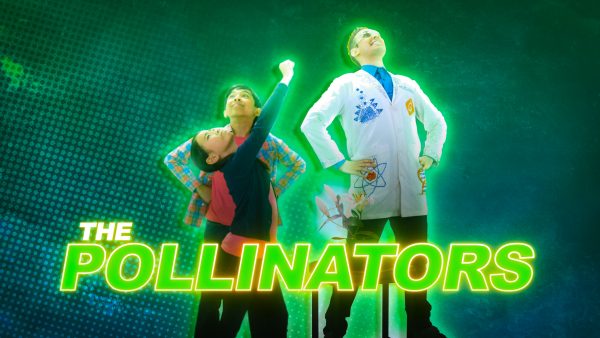Seed Dispersal Definition
Seed dispersal moves seeds to new places. For example, wind blows dandelion seeds away from their parent plant.
View Lesson on Pollination and Seed Dispersal
Become a member to get full access to our entire library of learning videos, reading material, quiz games, simple DIY activities & more.
Become a member to get full access to our entire library of learning videos, quiz games, & more.
Plans & Pricingto watch this full video.

Access All Videos
and Lessons, No Limits.
Access All Videos

No credit card required,
takes 7 sec to signup.
No card required

Ready-to-go lessons
that save you time.
Ready-to-go lessons
If you are on a school computer or network, ask your tech person to whitelist these URLs:
*.wistia.com, fast.wistia.com, fast.wistia.net, embedwistia-a.akamaihd.net
Sometimes a simple refresh solves this issue. If you need further help, contact us.
Pollination and Seed Dispersal
Fun Facts
- Coconuts float in the ocean for seed dispersal.
- Animals eat fruit and poop out seeds elsewhere.
- Maple seeds spin like a helicopter, aiding wind dispersal.
Why Do We Need To Know About Seed Dispersal
Learning about how seeds spread can help us come up with new technology. For example, the idea for Velcro came from how seeds stick to animal fur. Studying seeds can lead to new inventions that we use every day and in many kinds of work.
Knowing how seeds spread is very useful in jobs like farming, protecting the environment, and creating new materials. Knowing how seeds move naturally can help us come up with eco-friendly materials. Learning about seeds is important for making things better for people and for nature.
Frequently Asked Questions
Check out the Full Lesson on Pollination and Seed Dispersal
In this lesson, we learn that:
- Pollen needs to be moved from one flower to another.
- Animals help plants move pollen and seeds.
- Wind and water also help plants move their seeds.
Related Topics
- Algae Definition
- Bioindicator Definition
- Biomimicry Definition
- Definition Of Shade
- Dissolve Definition
- Distillation Definition
- Electromagnetic Spectrum Definition
- Energy Conversion Definition
- Frequency Definition
- Group Behavior Definition
- Humidity Definition
- Larvae Definition
- Law Of Conservation Of Matter Definition
- Lever Definition
- Life Cycle Definition
- Light Reflection Definition
- Liquid Nitrogen Definition
- Material Definition
- Metamorphosis Definition
- Mold Fossils Definition
- Moon Definition
- Muscular System Definition
- Non-renewable Energy Definition
- Nucleus Definition
- Parasitism Definition
- Partial Eclipse Definition
- Pattern Definition
- Period Definition
- Phases Of The Moon Definition
- Plant Definition
- Pollen Definition
- Pollination Definition
- Pollinator Definition
- Prey Definition
- Reproduction Definition
- River Definition
- Seed Definition
- Seed Dispersal Definition
- Seismologist Definition
- Soil Definition
- Solubility Definition
- Sound Definition
- Surface Runoff Definition
- Temperature Definition
- Texture Definition
- Vibrating Definition
- Water Quality Definition
- Wave Definition
Start a Free Trial Today. Get a $5 Amazon Gift Card!
Teachers! Start a free trial & we'll send your gift card within 1 day. Only cards left. Try it now.
Select Grade
Select Subject
This email is associated with a Science Kit subscription. Kit subscriptions are managed on this separate page: Manage Subscription

-
Download InvoiceScience & Math$/yr
-
Download InvoiceScience Only$/yr

access all lessons
• No credit card required •
"My students loved the videos. I started the video subscription in May and used them as a review before the state test, which I know contributed to 100% of my class passing the state test."
Rhonda Fox 4th Grade Teacher, Ocala, Florida
Use Generation Genius in Your School
Access all lessons free for 30 days.
"My students loved the videos. I started the video subscription in May and used them as a review before the state test, which I know contributed to 100% of my class passing the state test."
Rhonda Fox 4th Grade Teacher, Ocala, Florida
• No credit card required •
Already a member? Sign In
* no credit card required *

* no credit card required *
* no credit card required *


to Discover the Benefits of Generation Genius
Learn How to Save for Your School & District!

no credit card required
Skip, I will use a 3 day free trial
Enjoy your free 30 days trial
-
Unlimited access to our full library
of videos & lessons for grades K-5. -
You won’t be billed unless you keep your
account open past your 14-day free trial. -
You can cancel anytime in 1 click on the
manage account page or by emailing us.
-
Unlimited access to our full library of videos & lessons for grades K-5.
-
You won't be billed unless you keep your account open past 14 days.
-
You can cancel anytime in 1-click on the manage account page.
Cancel anytime in 1-click on the manage account page before the trial ends and you won't be charged.
Otherwise you will pay just $10 CAD/month for the service as long as your account is open.
Cancel anytime on the manage account page in 1-click and you won't be charged.
Otherwise you will pay $10 CAD/month for the service as long as your account is open.
We just sent you a confirmation email. Enjoy!
DoneWe use cookies to make your experience with this site better. By using this site you agree to our use of cookies. Click "Decline" to delete and block any non-essential cookies for this site on this specific property, device, and browser. Please read our privacy policy for more information on the cookies we use.Learn More
We use cookies to improve your experience. By using this site, you agree to our use of cookies. Click "Decline" to block non-essential cookies. See our privacy policy for details.Learn More




























































































































